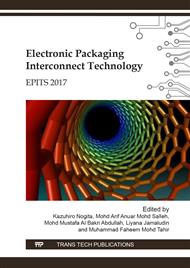[1]
M. A. A. MohdSalleh, Microstructure Formation in Reinforced Sn-Cu Lead-free Solder Alloys, The University of Queensland, (2016).
Google Scholar
[2]
C. Aksoy, T. Mousavi, G. Brittles, C. R. M. Grovenor, and S. C. Speller, IEEE Trans. Appl. Supercond., vol. 26 (2016), p.3.
DOI: 10.1109/tasc.2016.2539423
Google Scholar
[3]
S. Cheng, C. M. Huang, and M. Pecht, Microelectron. Reliab., (2016) p.1.
Google Scholar
[4]
X. Hu, Y. Li, Y. Liu, and Z. Min, J. Alloys Compd., vol. 625 (2015), p.241.
Google Scholar
[5]
J. Zhao, L. Qi, X. M. Wang, and L. Wang, J. Alloys Compd., vol. 375 (2004), pp.196-201.
Google Scholar
[6]
B. L. Silva, A. Garcia, and J. E. Spinelli, J. Alloys Compd., vol. 691 (2017), p.600.
Google Scholar
[7]
X. Hu, K. Li, and Z. Min, J. Alloys Compd., vol. 566 (2013), p.239.
Google Scholar
[8]
H. Chen, Y. L. Tsai, Y. T. Chang, and A. T. Wu, J. Alloys Compd., vol. 671 (2016), p.100.
Google Scholar
[9]
M. A. A. MohdSalleh, A. M. M. Al Bakri, M. H. ZanHazizi, F. Somidin, N. F. MohdAlui, and Z. A. Ahmad, Mater. Sci. Eng. A, vol. 556 (2012), p.633.
Google Scholar
[10]
M. A. A. MohdSalleh, S. D. McDonald, Y. Terada, H. Yasuda, and K. Nogita, Mater. Des., vol. 82 (2015), p.136.
Google Scholar
[11]
S. A. Musa, M. Arif, A. Mohd, and N. Saud, Adv. Mater. Res. vol. 795 (2013), p.519.
Google Scholar
[12]
M. J. Rizvi, Y. C. Chan, C. Bailey, H. Lu, and M. N. Islam, J. Alloys Compd., vol. 407 (2006), no. 1–2, p.208.
Google Scholar
[13]
C. B. L. & S. B. J. J.W. Yoon, Mater. Sci. Technol., vol. 19 (2003), p.1101.
Google Scholar
[14]
M. L. Huang and L. Wang, Metall. Mater. Trans. A, vol. 36 (2005), p.1439.
Google Scholar
[15]
M. H. Mahdavifard, M. F. M. Sabri, D. A. Shnawah, S. M. Said, I. A. Badruddin, and S. Rozali, Microelectron. Reliab., vol. 55 (2015), p.1886.
Google Scholar
[16]
O. Krammer, T. Garami, B. Horváth, T. Hurtony, B. Medgyes, and L. Jakab, J. Alloys Compd., vol. 634 (2015), p.156.
DOI: 10.1016/j.jallcom.2015.02.092
Google Scholar
[17]
P. L. Sudan Ahmed, MunshiBasit, Jeffrey C. Suhling, 15th IEEE Intersociety Conf. on Thermal and Thermomechanical Phenomena in Electronic Systems, 2016, p.746.
Google Scholar
[18]
K. Nogita et al., Int. Conf. on Electron. Packag, 2017, p.2.
Google Scholar
[19]
S. A. Belyakov, T. Nishimura, K. Sweatman, K. Nogita, and C. M. Gourlay, 2016 Int. Conf. Electron. Packag. ICEP 2016, p.222.
Google Scholar
[20]
Y. Zhong, W. Liu, C. Wang, X. Zhao, and J. F. J. M. Caers, Mater. Sci. Eng. A, vol. 652 (2016), p.264.
Google Scholar
[21]
M. A. A. Mohd Salleh, R. M. Said, N. Saud, H. Yasuda, S. D. McDonald, and K. Nogita, Key Eng. Mater., vol. 700 (2016), p.161.
Google Scholar
[22]
B. Sandy, E. Briggs and R. Lasky, Indium Corp. Tech Pap., (2011), p.1.
Google Scholar
[23]
D. B. Witkin, Mater. Sci. Eng. A, vol. 532 (2012), p.212.
Google Scholar
[24]
D. B. Witkin, J. Electron. Mater., vol. 41 (2012), p.190.
Google Scholar
[25]
S. A. Belyakov, J. W. Xian, K. Sweatman, T. Nishimura, T. Akaiwa, and C. M. Gourlay, J. Alloys Compd., vol. 701 (2017), p.321.
DOI: 10.1016/j.jallcom.2016.12.404
Google Scholar
[26]
L. Yang, S. Fenglian, and V. Liu, IFOST: Int. Forum on Strategic Tech., 2010, p.1.
Google Scholar
[27]
C. Z. L. T.y. Kang, Y.Y. Xiu, L. Hui, J.J. Wang, W.P. Tong, J. Mater. Sci. Technol., vol. 27 (2011), p.741.
Google Scholar
[28]
F. Gnecco et al., Int. J. Adhes. Adhes., vol. 27 (2007), p.409.
Google Scholar
[29]
A. A. El-Daly, A. M. El-Taher, and S. Gouda, J. Alloys Compd., vol. 627 (2015), p.268.
Google Scholar
[30]
M. N. ErvinaEfzan, M. N. NurFaziera, and M. M. A. B. Abdullah, AIP Conf. Proc., vol. 1835 (2017), p.1.
Google Scholar
[31]
H. R. Kotadia, P. D. Howes, and S. H. Mannan, Microelectron. Reliab., vol. 54 (2014), p.1253.
Google Scholar
[32]
M. Abtew and G. Selvaduray, Mater. Sci. Eng. R Reports, vol. 27 (2000), p.95.
Google Scholar
[33]
G. Ren, I. J. Wilding, and M. N. Collins, J. Alloys Compd., vol. 665 (2016), p.25.
Google Scholar
[34]
R. K. Chinnam, C. Fauteux, J. Neuenschwander, and J. Janczak-Rusch, Acta Mater., vol. 59 (2011), p.1474.
Google Scholar
[35]
S. Schindler, M. Mueller and S. Wiese, Electronics System-Integration Conf., (2014).
Google Scholar
[36]
M. A. A. M. Salleh, S. D. Mcdonald, and K. Nogita, vol. 242 (2017), p.235.
Google Scholar
[37]
M. A. A. Mohd Salleh, S. McDonald, and K. Nogita, Appl. Mech. Mater., vol. 421(2013), p.260.
Google Scholar


